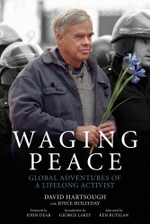S. Brian Willson is a Viet Nam veteran, trained lawyer, long time peace activist, and member of Veterans For Peace.

We are fortunate to finally have David Hartsough’s Waging Peace, an extraordinary description of his amazing sixty-year journey as an activist spanning the entire Cold War and continuing to the present. As one of today’s authentic elders, Hartsough offers us a body of experiential knowledge presented in dramatic detail sometimes easily forgotten in today’s digital era of short memories.
Hartsough excitedly shares wisdom garnered from a broad range of experiences: direct, nonviolent confrontation of Cold War policies during his travels in Europe as well as in the US; active participation in the Civil Rights movement (he met Martin Luther King, Jr. at age 15); becoming a conscientious objector to US military conscription in the 1950s; participating with others in physically blocking weapons and military ships headed for Viet Nam; actively obstructing, with hundreds of others, the construction of nuclear power plants; accompanying aggrieved, impoverished campesinos facing historically repressive military threats in El Salvador, Guatemala, Mexico, and Palestine; facing death squads in the Philippines and Chiapas, Mexico; visiting Russia during the Cold War and again in 1991 when he joined many Russians in efforts to avert a coup ousting the reformer Mikhail Gorbachev; leading delegations to Iran creating citizen-to-citizen diplomacy; traveling over the years to the region of ex-Yugoslavia in efforts to participate in strategic nonviolent alternatives to the violence unleashed when Yugoslavia was broken up significantly due to US policies; recently protesting drone warfare with increasing numbers of others by obstructing entrances to drone bases in efforts to confront the most insidious and diabolical of all terror policies; among many, many examples of citizen power.
In the chapter, “Assault on the Tracks: Facing Violence With Love and Courage,” Hartsough describes his first-person, eyewitness account of the horrendous assault – attempted murder – that occurred at the Concord, California Naval Weapons Station on September 1, 1987—the first such account to be published, as far as I know. He was one of many protestors, organized under the name Nuremberg Actions that had been vigiling all summer, in direct confrontation of the movement of munitions by train and truck from the Pentagon’s largest West Coast arsenal. Hundreds had already been arrested and jailed for trying to stop the flow of munitions to El Salvador and Nicaragua, where they were being used to murder and maim thousands of campesinos struggling for justice after decades of brutal, US-supported repression. President Reagan had signed new executive orders to counter “terror” at home and abroad, in effect reinstituting the FBI’s feared COINTELPRO—orders that remain in effect today. Reagan made the ridiculous claim that these impoverished people in Central America were creating a Soviet-inspired Communist beachhead “just two days driving time from Harlingen, Texas,” and that the US Americans dissenting from his policies of murder were terrorists themselves. On that day in September 1987, three veterans, after providing plentiful notice and surrounded by 40 others in solidarity, including Hartsough, began a munitions train blocking action just before noon. The train speed limit was 5 mph, its legal protocol required it to always stop awaiting arrests by police when demonstrators were present on the tracks. Two Navy spotters always stood on the front platform of the locomotive in radio contact with the engineer to assure clear tracks. On this particular sunny day, the locomotive accelerated to 17 mph, more than three times the legal speed limit, catching everyone off guard. One blocker (this reviewer) was unable to get off in time, losing both legs below the knee and suffering a fractured skull among a multitude of injuries. Hartsough, standing immediately next to the tracks, had his arm struck by the speeding locomotive knocking him to the ground from which vantage point he observed the dragged blocker “getting smashed from side to side as the train continued another four hundred feet before stopping,” Of all of his years of resistance, Hartsough described this as “the most horrible experience of my life.”
In 2003, as a result of his many observations of conflicts in various countries, Hartsough helped launch the Nonviolent Peace Force (NPF), deploying teams of multinational citizens trained in nonviolence to accompany and stand in defense of endangered people in critical global locations.
Hartsough’s inspiring life story teaches us so much about the power of conscience and militant nonviolence, shaped by his years of participation with thousands of others in creative and educational resistance actions. He and his family also have modeled “right livelihood,” with modesty and humble simplicity, conscious of the old motto, often ascribed to Gandhi, “live simply that others may simply live.”
This is a primer for learning many practical approaches to militant, nonviolent revolution. Read and study it. You will not be sorry.

